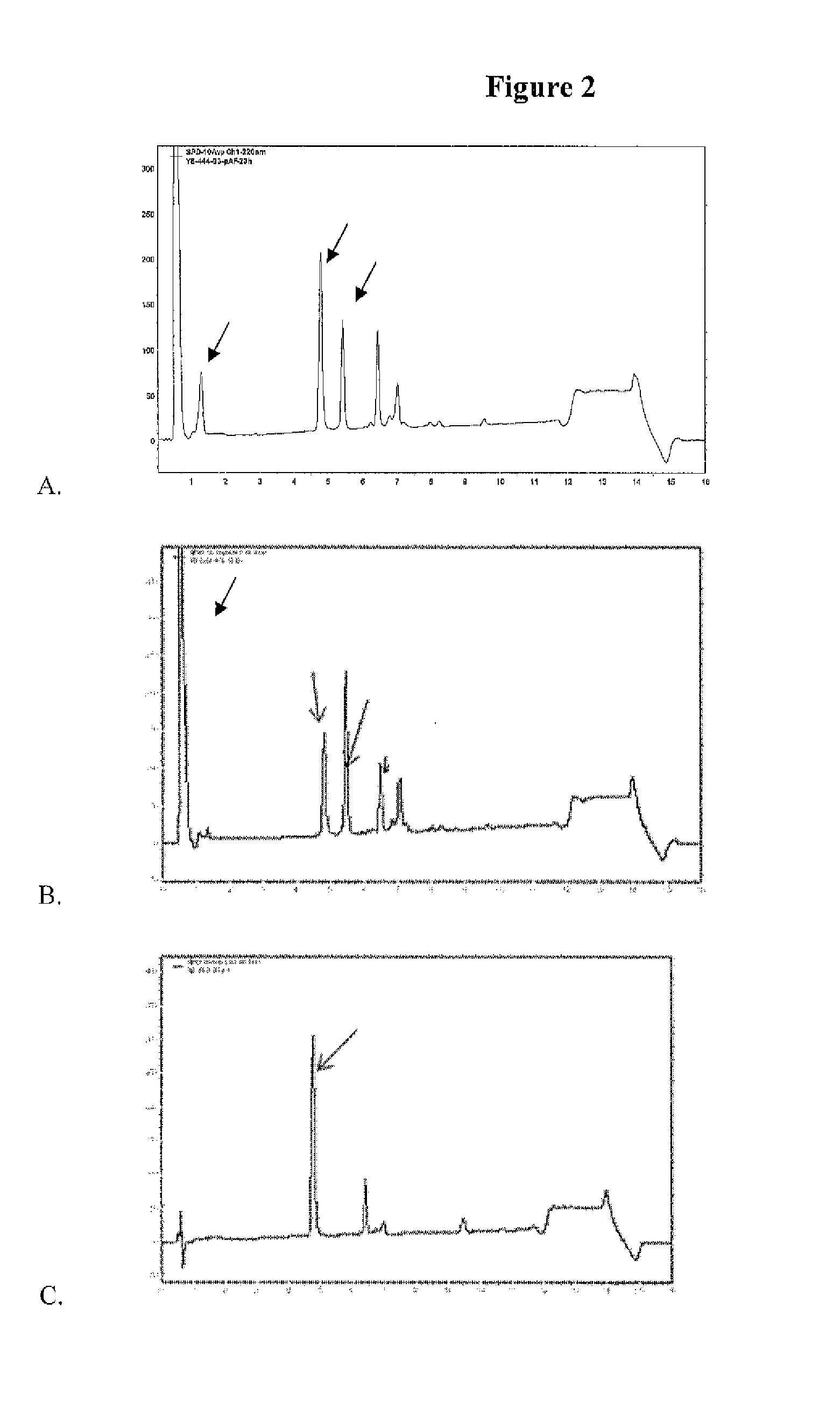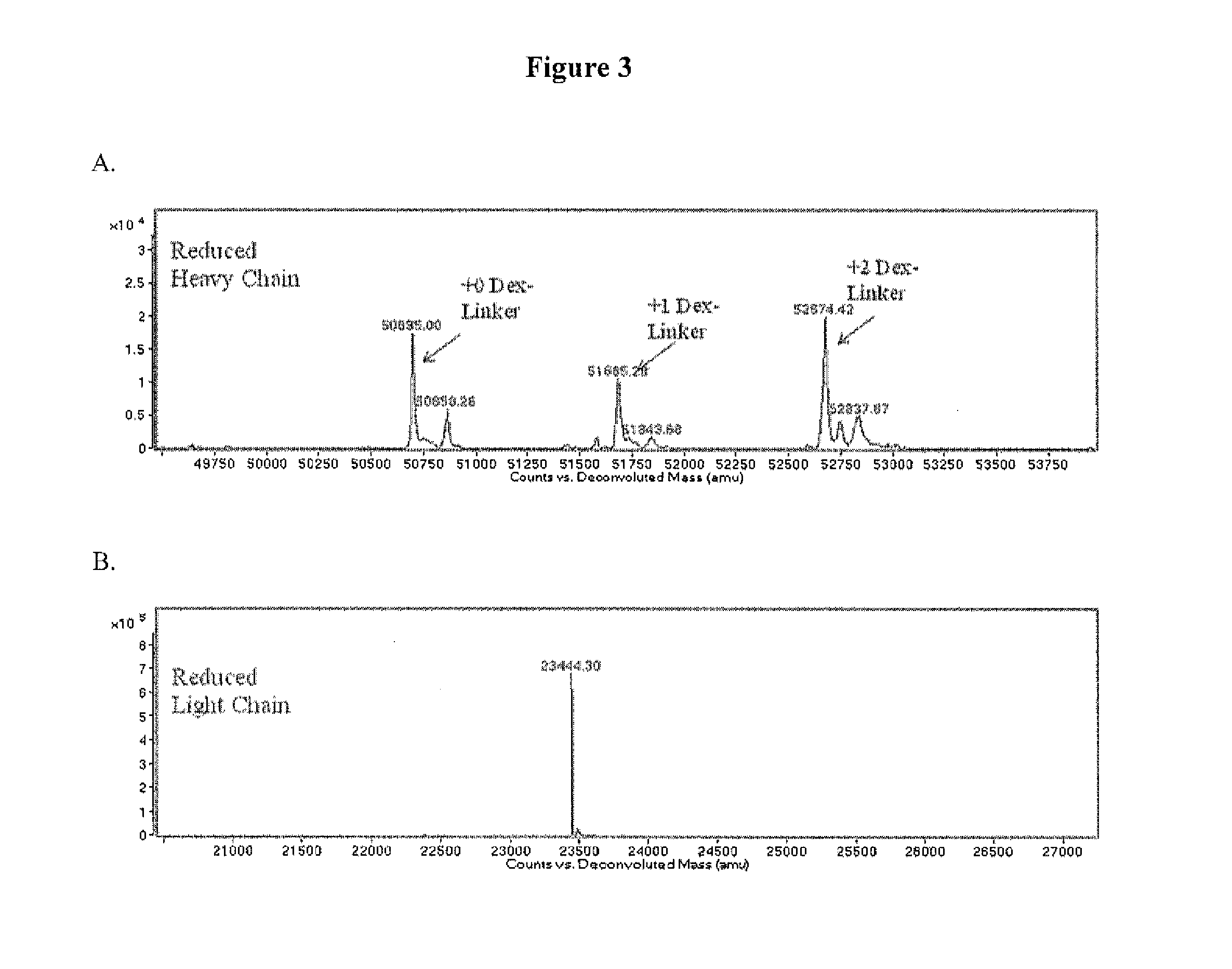Anti-PSMA Antibodies Conjugated to Nuclear Receptor Ligand Polypeptides
a technology of nuclear receptor ligand and anti-psma antibody, which is applied in the field of antiprostate specific membrane antigen antibodies, can solve the problems of limiting its usefulness as imaging agent for the detection of psma, and achieve the effects of prolonging the action time, and improving the resistance to proteases
- Summary
- Abstract
- Description
- Claims
- Application Information
AI Technical Summary
Benefits of technology
Problems solved by technology
Method used
Image
Examples
example 1
Synthesis of Compound 1
[1090]1. Detailed Synthesis of Compound 1 shown in FIG. 8
1a. Synthesis of Compound 1-3
[1091]To a mixture of Dexamethasone 1-1 (0.4 g, 1.02 mmol) and N, N′-disuccinimidyl carbonate (0.4 g, 1.33 mmol) in DCM (4 ml) and THF (4 ml) was added DIEA (0.36 ml, 2.04 mmol) at room temperature. The mixture was stirred at room temperature overnight. The mixture was concentrated and the crude product was purified by column chromatography. 0.13 g of 1-3 was obtained as white solid (24%). LCMS m / z=534 [M+H]+
1b. Synthesis of Compound 1-7
[1092]To a mixture of 1-4 (0.3 g, 0.6 mmol), 1-5 (0.12 g, 0.66 mmol) and EDC (0.2 g, 1.2 mmol) in DMF (6 ml) was added 1N NaHCO3 (1.8 mmol) solution at 0° C. The mixture was stirred at room temperature overnight. It was extracted with EtOAc (3×30 ml). Washed with 0.5M HCl and brine. The organic layer was dried over anhydrous MgSO4. It was filtered and concentrated under reduced pressure to give the product 1-6 as white solid,
[1093]A mixture of...
example 2
Synthesis of Compound 2
[1097]2. Detailed Synthesis of Compound 1 shown in FIG. 9
2a. Synthesis of Compound 2-2
[1098]To a mixture of 1-3 (0.1 g, 0.19 mmol) and tert-butyl 2-aminoethylcarbamate (30 mg, 0.19 mmol) in acetonitrile (2 ml) was added DIEA (0.098 ml, 0.56 mmol) at room temperature. The mixture was stirred at room temperature overnight. The white precipitate was filtered and washed with ether to give the product 2-1 as white solid,
[1099]A mixture of 2-1 (0.1 g) and 4N HCl in dioxane (1 ml) was stirred at room temperature for 1 hour. It was concentrated under reduced pressure to give the product 2-2 as white solid. The product was used without further purification. LCMS m / z=479 [M+1-1]+
2b. Synthesis of Compound 2-4
[1100]To a mixture of 2-2 (0.09 g, 0.188 mmol) and Fmoc-Val-Cit-PAB-PNP (0.159 g, 0.21 mmol) in DMF (1 ml) was added DIEA (0.16 ml, 0.94 mmol) at room temperature. The mixture was stirred at room temperature overnight. The crude product was purified by HPLC to give 0...
example 3
Synthesis of Compound 3
[1105]3. Detailed Synthesis of Compound 3 shown in FIG. 10.
3a. Synthesis of Compound 3-1
[1106]To the solution of compound 3 (600 mg, 1.125 mmol) in 0.5 mL of DMF was added tert-butyl methyl (2-(methylamino)ethyl)carbamate (127 mg, 0.675 mmol). The resulting solution was stirred at room temperature for 2 hrs. The reaction mixture was diluted with EtOAc and washed with H2O, brine, dried over Na2SO4, and then concentrated to dryness. The residue was purified by flash column chromatography to give 170 mg of compound 3-1. MS (ESI) m / z 607 [M+H].
3b. Synthesis of Compound 3-2
[1107]Compound 3-1 (170 mg) was treated with 50% TFA in DCM. The reaction was concentrated to dry after 30 min. The product was directly used in next step without further purification.
3c. Synthesis of Compound 3-3
[1108]To the solution of compound 3-3 (0,28 mmol) in 1,5 mL of DMF was added Fmoc-Val-Cit-PAB-OPNP (215 mg, 0,28 mmol), HOBt (21.4 mg, 0.14 mmol) and DIEA (99 □l, 0.56 mmol). The resulti...
PUM
 Login to View More
Login to View More Abstract
Description
Claims
Application Information
 Login to View More
Login to View More - R&D
- Intellectual Property
- Life Sciences
- Materials
- Tech Scout
- Unparalleled Data Quality
- Higher Quality Content
- 60% Fewer Hallucinations
Browse by: Latest US Patents, China's latest patents, Technical Efficacy Thesaurus, Application Domain, Technology Topic, Popular Technical Reports.
© 2025 PatSnap. All rights reserved.Legal|Privacy policy|Modern Slavery Act Transparency Statement|Sitemap|About US| Contact US: help@patsnap.com



